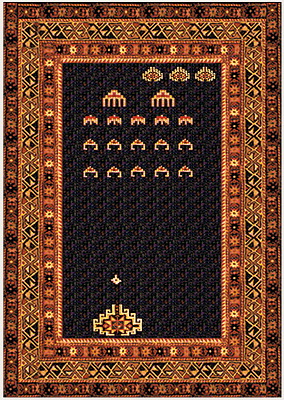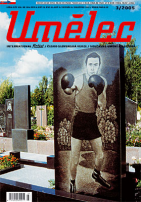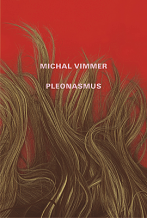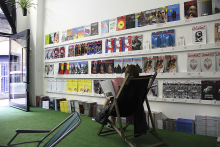| Umělec magazine 2005/3 >> The Oldest Fire In Poland | List of all editions. | ||||||||||||
|
|||||||||||||
The Oldest Fire In PolandUmělec magazine 2005/301.03.2005 Jiří Ptáček | poland | en cs de es |
|||||||||||||
|
When I first noticed the plastic digital watch made by Janek Simon, a Polish artist, I assumed he had some particular reason for not simply buying one. But Simon, who was born in 1977, grew up in real socialism. Perhaps he couldn’t get over a childhood trauma.
Digital watches used to be cult objects for Poles, Czechoslovaks and the Soviets. The watches were deified as the ultimate unattainable object of desire; like Rubik’s cubes, video cassettes or soda cans, the watches defined the social pecking-order for kids. Janek Simon told me there is something more to his watch; it is not just for remembrances of things past, when Socialism was dreaming of consumption; the watch is also a political manifestation of the present. Simon gradually obtained instructions how to construct the watch from the internet. He proceeded the way a gardener might set up a greenhouse in the Bahamas, with Siberian tundra pines, or an Islamic extremist making maximal explosive force out of commonly accessible sources. Simon’s watch is not only an amusing souvenir; it is a message explaining how to incorporate new approaches to information to achieve self-realization. In its own way, the watch defines all aspects of what this 28-year-old artist from Krakow puts into his works: the imagery and memory of his generation, his “Polish” presence, participation in global events, and politics. It is all carried out in the form of some character test. The World Needs Our Records Power, records and outstanding results are the driving forces of our civilization. The stock exchange index and GNP statistics document society’s rise and fall. Slowness, incompleteness and mediocrity were relegated to the individual’s inner conscience. Only those who have beaten some record are able to draw attention to themselves. The world is separated into those who are exceptional, and those behind them who must identify themselves with the record holders to experience some feeling of success. “I am going for gold,” boasted Roman Šebrle, the Czech multi-event athlete, before the world decathlon championship, and touched hundreds of hearts all over the country. Simon approaches this irrational tangle with an ironical urge to enliven it. Simon takes on the Polish titan, ski jumper Adam Malysz, setting him in a video-loop endlessly flying through the air. For many, this fires up an unexpected interest and solidarity — a thrill known by everybody who has ever watched a sporting event. During moments when an athlete isn’t entirely able to confirm a unique status, our muscles unwittingly twitch. However, should the targeted peak moment fail to arise, the tension collapses – into a loss of interest. Self-presentation Parasite Simon’s work entitled The Oldest Fire in Poland deals with a different national record. A miniature geological cross-section of soil layers is enclosed in a small plexiglass box. Smoke wafts up from the dirt. The object is accompanied by documentary photographs of a smoldering waste dump near Nowa Ruda in Poland, where a mine that caught fire ages ago has never been extinguished. Even though the mine entrance has been filled in, the smoke persists to the present day, and the dump has become a renowned tourist attraction. In this work, Simon enhances his own attractiveness through the allure of utterly unrelated things. It reminds me of an Austrian musician who told me about the crest of his career in an event unrelated to music: it was a brief period in which he taught English to a young bodybuilder, Arnold Schwarzenegger. Simon’s ironical concepts demonstrate a similar parasitism. In 2004, Simon participated in the Re:location project, run by the Luxembourg Casino. For several exhibitions realized in Western and Eastern Europe, artists mutually entered unusual contexts and various perspectives to explore the theme of relocation and its limits. The closing event was a collective exhibition of the results of several workshops in Luxembourg Casino. Participating in this, Simon contributed a small-scale gallery model and placed his own retrospective in its tiny halls. Whereas other participants each presented a single project, Simon managed to show “all-in-one.” Simon did not study art, but sociology and psychology. And even though he is now devoted to art, he examines the qualities that we do not readily confess to, making us exposed, frail icons of “individuality.” Simon belongs to the young generation of artists who well know how to exploit local life and institutions to uncover general patterns of behavior according to which we act and are influenced. He directs his irony toward himself and is open about his own aspirations for self-realization. He hits at the world of record-breaking and unheard-of art so hard that it becomes a record itself. For the Hit gallery in Bratislava he tapes bread together and attaches it to the wall to make the longest baguette you have ever seen. Humor with Sweet Violence Humor. Sometimes I think Polish art can be distinguished from the rest of the world for its humor: It is ironic, blasphemous, (anti)consumer, and yet it often deals with the mundane. Values perfectly devalued thus seem even more entertaining. It is amazing to stay sane in such an atmosphere. It may resemble Czech humor in a way too. Or at least its myth. For Polish artists, humor has become myth as well, and it is not so easy to bypass it. Janek Simon does not go against the myth, but rather enriches it with a subliminal sweet conscience of the associated violence. It can be set upon us as much as we can go at it. His video installation Carpet Invaders (2002) is based on an abstract pattern on a Caucasian carpet, but functions as a video game in the rather primitive, brief style of the 80s. A nice recollection of the recent past of computer games is confronted with swelling collective understanding that “Islamic” denotes “dangerous” and “violent.” Their similarity is alarming to those rugs which originated during the Russian occupation of Afghanistan: their pattern was of Kalashnikovs, grenades and helicopters. Even more meaningful is Simon’s latest computer game called Total Chess (2004). During the game on a small playing table, the chess pieces suddenly explode. The most ”peaceful sport” returns to the metaphor of war, in which it is based. Waging war is compared as well with a game of chess. Such works are clearly connected with the present and with the paradoxes of our behavior. We give ourselves to violent simulations, we experience mediated violence; we are attached to it. But we are still afraid of it; we are afraid of giving it such a passing glance. Neuron systems do not allow us understand violence enough to “take it out of service.” Simon offers a clear parallel of virtual hedonism and the real world. It is only up to us whether we seize it. It is also possible to shoot’em all to the end.
01.03.2005
Recommended articles
|
|||||||||||||
|
04.02.2020 10:17
Letošní 50. ročník Art Basel přilákal celkem 93 000 návštěvníků a sběratelů z 80 zemí světa. 290 prémiových galerií představilo umělecká díla od počátku 20. století až po současnost. Hlavní sektor přehlídky, tradičně v prvním patře výstavního prostoru, představil 232 předních galerií z celého světa nabízející umění nejvyšší kvality. Veletrh ukázal vzestupný trend prodeje prostřednictvím galerií jak soukromým sbírkám, tak i institucím. Kromě hlavního veletrhu stály za návštěvu i ty přidružené: Volta, Liste a Photo Basel, k tomu doprovodné programy a výstavy v místních institucích, které kvalitou daleko přesahují hranice města tj. Kunsthalle Basel, Kunstmuseum, Tinguely muzeum nebo Fondation Beyeler.
|







































 We Are Rising National Gallery For You! Go to Kyjov by Krásná Lípa no.37.
We Are Rising National Gallery For You! Go to Kyjov by Krásná Lípa no.37.
Comments
There are currently no comments.Add new comment